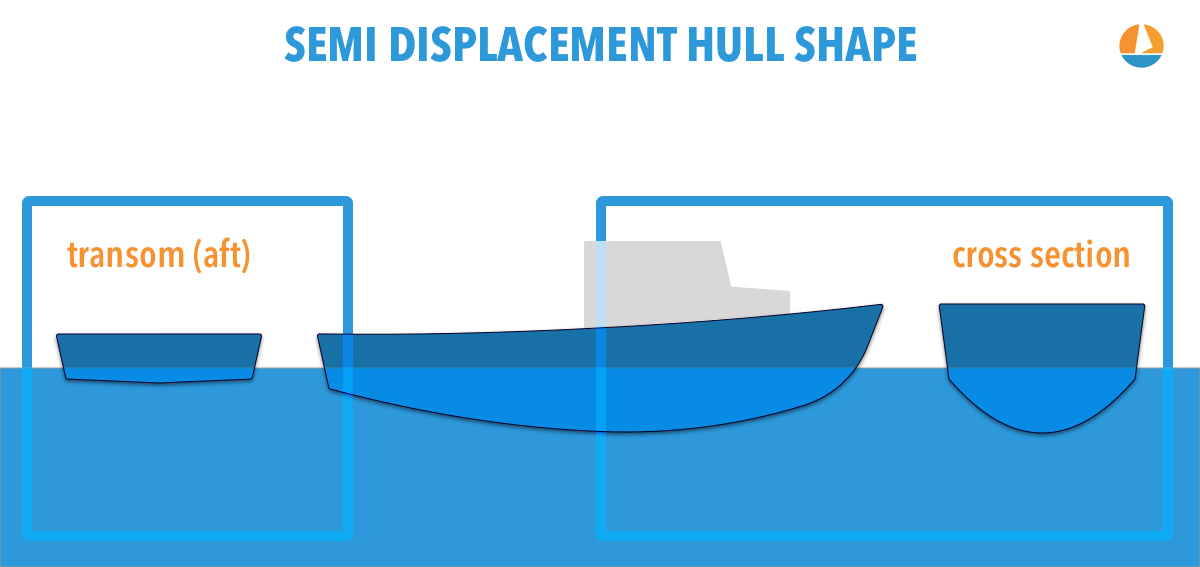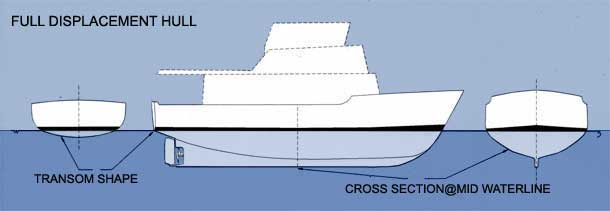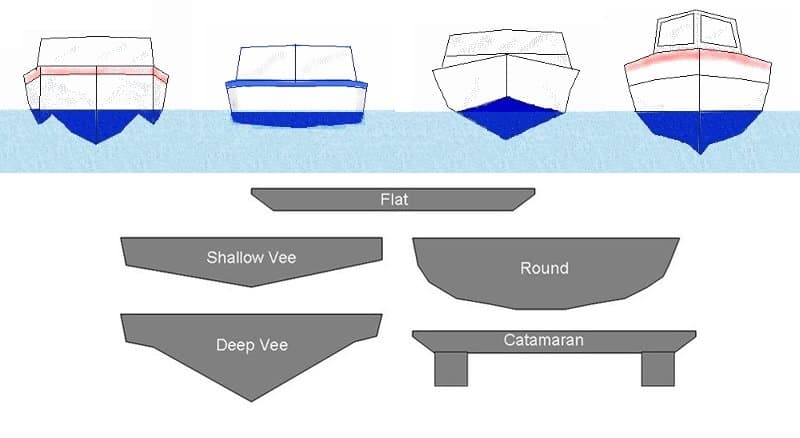A boat with a displacement hull may ordinarily be distinguished by a deep V shape to its bottom or hull. For practical purposes rather than strictly theoretical ones it is the wave making property of the typical displacement hull that causes the rapid rise in resistance and is related to boat length the wave system set up that is parallel to the direction of travel propagates predictably according to speed in that a given speed gives a given wave length it is when the.
A semi-displacement hull displaces water at low speeds but is able to semi-plane at cruising speeds.

. Until hull 65 1985 they were built with glass-over-plywood decks. The absolute best hull type for rough water. Hulls do come in several shapes.
Its seaworthy and can be. They are designed to move with very little propulsion or force. The displacement hull is efficient and very dependable in rough waters.
Displacement Ships with this hull move through the water by displacing water meaning it pushes the water aside. This type of hull is designed to push through the water moving or displacing the water in a. Semi-Displacement Hulls Semi-Displacement Hull Boats.
For centuries boats were constructed using a displacement hull design by which their bottoms were either flat or melon shaped. The Best Hulls for Rough Waters To get up to speed heres a quick overview. This hull type is the least understood as it operates in a speedlength region partially supported by buoyancy like a displacement hull and partly by dynamic forces like a planing hull.
They behave like displacement hulls at low speed but pop up onto a plane usually around 15-16 MPH depending on the design and load. S-Shaped Hulls S-Shaped Smooth Displacement Hull. Boats with displacement hulls are limited to slower speeds.
But overall there are really only two types of hull namely a displacement- and a planing hullThese descriptions refer to the way in which the hull moves through or over the water and the way in which their designers treat Archimedes principle whether knowingly or not. These hulls are smooth and typically lack the chined designs of planing hulls. There are two essential types of powerboat hulls.
It holds up the boat using buoyancy. The amount of water displaced is equal to the weight of the ship itself. Making this hull the most fuel-efficient desired for trans-oceanic crossings.
A displacement hull and a planing hull. A semi displacement hull creates a big whole in the water which generate large bow and stern waves. This type of hull is designed to push through the water moving or displacing the water in a proportion equal to the weight of the boat.
Longitudinal symmetry and displacement-to-length ratio DL. Planing hulls come in a variety of shapes each of which has it benefits and disadvantages. A large ship a tugboat a barge or a sailboat are displacement hulls.
Semi displacement hulls will typically have a similar hull shape to. These displacement designs cruised through the water by displacing water around the hull. A round-bottomed hull shape acts as a displacement hull.
The Beneteau Swift Trawler 34s semidisplacement hull gives it some of the stability and seaworthiness characteristics of a displacement hull while offering more speed. Nothing could be further from the truth. With a displacement hull there is no significant advantage in using an engine that will drive the vessel faster than nominal hull speed at 70 or 80 percent of rated RPM.
Most powerboats and personal watercraft have planing hulls that ride on the water at higher speeds. Thereafter they were built with a cored deck and superstructure. All three of these hull types come with their own unique advantages and disadvantages.
Which of these hulls is a displacement hull. It is claimed that hulls cannot go significantly faster than this without planing. Most large cruisers and most sailboats have displacement hulls allowing them to travel more smoothly through the water.
The hull is solid fiberglass below the waterline and cored above. A planing hull lies on top of the water as it moves and holds up the boat using lift. It is called the displacement trap but is a myth.
For a displacement hull the so-called hull speed occurs when the waves it generates are the same length as the hull. Semi displacement hulls are normally a cross between a planning and displacement hull they will generate an amount of lift but the vessels weight will be supported by buoyancy. This occurs when the speed-length ratio is 134.
An iconic Krogen design with a ballasted displacement hull and tremendous storage a proven cruising or liveaboard yacht. With the same amount of horsepower applied hulls with a lower DL ratio will cruise at a faster speed than hulls with a higher DL ratio. There are two essential types of powerboat hulls.
Displacement hulls are often rounded and would be termed round bottom hulls. Describing a full displacement hull is very similar. We can differentiate between full displacement hulls based upon two form fundamentals.
Different Yacht Hull Types. A boat with a displacement hull may ordinarily be distinguished by a deep V shape to its bottom or hull. The big hull speed myth.
A semi-displacement hull displaces water at low speeds but is able to semi-plane at cruising speeds. The displacement hull is definitely the go-to hull for rough water sailing. A round bottom powerboat has little or no discontinuity in the curve of its section between the gunwale and keel.
This is the oldest design for ships and boats. An s-shaped hull is typical of deep bottom canoes and of course sailboats having the most extremely pronounced deep keel. The planing hull is extremely fast and agile.
A speedboat or a jetski are planing hulls. Unfortunately many people tend to think that all full displacement vessels are the same. There are three main categories of hulls.
A displacement hull lies inside the water and displaces it as it moves. A round bottom provides a soft ride at the hull speed. The semi-displacement hull is a bit of both.
A displacement hull and a planing hull. Many types of boats today such as ocean tankers trawlers river barges and standard sailboats have displacement hulls.

Semi Displacement Hulls Explained Illustrated Guide Improve Sailing
Boats 101 River Runners And Creek Boats Blister

Srd Is A Better Hull Shape Fast Fuel Efficient Stable

A Input Semi Displacement Yacht Hull B Modified Yacht Hull Download Scientific Diagram

Srd Is A Better Hull Shape Fast Fuel Efficient Stable

0 comments
Post a Comment